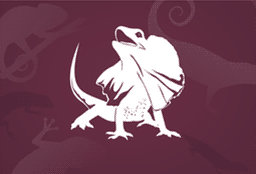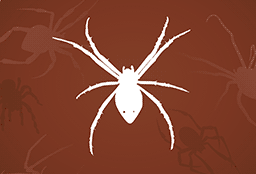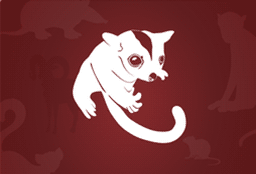Black and white, with the pattern varying across its range. The back of its neck, upper tail and shoulders (on its wings) are white in males and grey in females, and (across most of Australia) the rest of its body is black. In south-eastern, central and south-western Australia, including Tasmania, its back and rump are entirely white. Its eye is red-brown. Young birds are usually grey rather than black and have dark eyes.
Distinctive feature
One toe faces backwards and three face forwards. It has a square-tipped tail.
The caterpillar (larva) is initially a pale yellow-grey, before turning green with long black hairs along its body. Its head is brown-black with short hairs. The female butterfly (adult) is orange with creamy yellow and dark brown patches towards the tip of its forewings (front wings). The male is less colourful, being brown and orange with no pale patches. It also has an obvious raised vein in the middle of its forewing. Both males and females have a small eye-spot on each wing. The undersides of the wings in both the male and female are paler with faint markings, and their hindwings have very few markings. The female’s hindwing is darker then its forewing. It is difficult to identify these butterflies when they are resting with their wings closed. The males emerge quite a while earlier in the year before the females.
Size
Caterpillar about 3.5 cm long; Butterfly wingspan 5.5 – 7.5 cm (females are larger than males).
Black and white, with the pattern varying across its range. The back of its neck, upper tail and shoulders (on its wings) are white in males and grey in females, and (across most of Australia) the rest of its body is black. In south-eastern, central and south-western Australia, including Tasmania, its back and rump are entirely white. Its eye is red-brown. Young birds are usually grey rather than black and have dark eyes.
Distinctive feature
One toe faces backwards and three face forwards. It has a square-tipped tail.
A dark grey to black bird with a yellow-tipped red bill, red frontal shield, red legs, and white undertails. Hatchlings are also black with red frontal shield, juveniles have green legs, green horn or black coloured bill, generally paler.
Size
35-40 cm (from head to tail)
This frog goes by several common names: Eastern Banjo Frog, Eastern Pobblebonk Frog and Southern Bullfrog. The first two are based on its distinctive 'bonk' call which sounds similar to the string of a banjo being plucked.
Its back ranges from grey, to olive-green, dark brown or black, with dark marbling or flecks. It has a pale yellow stripe running from under its eye to its arm, a dark band above this, and may also have a pale stripe running down its back. Its sides commonly have a purple or bronze sheen, mottled with black. Its belly is white and sometimes mottled with grey. Its back is warty and rough but its belly is smooth.
Distinctive feature
A prominent gland on the outer side of its hind leg (its shin) and a fleshy lump at the base of each hind foot.
The top of the adult male's head is grey-black, extending in a line down either side of its white breast. Its throat is also white, with a rufous patch in the centre. Its wings and lower back are dark metallic grey and its upper back and underneath are buff. In flight, its white outer tail feathers are visible. The female has similar but duller colouring. A young bird has less distinct markings with dark olive on top of its head, a white chin and throat and a cinnamon chest and belly.
Distinctive feature
It has a very long, fine beak that curves downward.
It has a grey back and head, and bright-yellow underparts. Southern birds have an olive-yellow rump, while birds in northern Australia have a brighter yellow rump. Its throat is off-white and when seen in flight, it has a pale bar on its wings. Its bill is black. Young birds are rufous-brown with paler streaks.
Size
13 – 17 cm long, the males are slightly larger
Bright yellow and black bands across its abdomen, with a pair of black spots and a black triangle on each yellow band. It has yellow legs, black antennae and two pairs of transparent wings. Nests are commonly built underground with only their small entrance holes visible, which are about 2 - 3 cm across.
Size
1.2 – 1.5 cm long (worker); 2 cm long (queen)
Dark slate-grey on its head, back and wings, and pale orange-brown below; its undertail is boldly barred black and white. Its legs and feet are dull yellow and its bill is black. Young birds are duller and browner, with mottled markings, especially on their breast and underparts.
Distinctive feature
A yellow eye-ring which is tinged green in young birds.
An adult male has a bright orange breast and throat, with white on its lower belly and under its tail. The upperparts are dark slate grey and there is a clear white stripe on its folded wing. It has a black beak and dark brown legs. A female is mostly grey-brown with a pale buff strip on its wing. Its outermost tail feather is mostly white. A young bird looks like an adult female, but its back has buff streaks and its belly is pale with brown streaks.
Size
12 - 14 cm
Grey-brown to bronze, with a dark stripe running along each side of its body from its nostril, across its eye to its tail, getting wider from its front legs. Its body pales below the stripe to a cream belly.
This species has a lighter body with a less obvious stripe running along its sides than the Southern Garden Skink.
Size
8 - 10 cm (nose to end of tail).
Grey-brown to bronze, with a dark stripe running along each side of its body from its nostril, across its eye to its tail, getting wider from its front legs. Its body pales below the stripe to a cream belly.
This species has a ‘heavier’ looking body and a more obvious stripe running along its sides, compared to the Northern Garden Skink.
Size
8 - 10 cm (nose to end of tail).
The female’s abdomen can be variable but is typically brown to yellow with short silvery-white hairs. The legs are usually black with bright yellow patches on the underside of the many leg joints. Its palps (small leg-like structures on either side of its fangs) are distinctly red.
It makes golden webs, after which it is named.
Size
Females are 4 – 4.5 cm long but the tiny males are only 5 – 6 mm long (body length). The Females can have a legspan of up to 15 cm!
The adult male has a bright-yellow underbody, olive-green back and wings, and a black head with a bright-yellow collar. Its throat is white, with a broad black band which separates it from the yellow breast. Its beak and legs are black. The adult female has grey upperparts with a pale olive tinge, and is pale grey below with a pale yellowish tinge. Its beak is dark brown and its legs are grey-brown. Both sexes have a red-brown eye. Juvenile birds are rufous above and below, and as they mature, gradually resemble a female, though they retain some rufous feathers in their wings.
Its head and upperparts are mostly dark grey, with a white eyebrow and throat, a narrow grey band across the upper breast and a creamy-buff belly. The feathers of its long tail have white edges and tips, and the tail is often fanned out.
Size
14 – 16 cm long
Dark grey to brown body, with lighter grey fur on its head and golden-orange fur encircling its neck. Its wings are black.
Distinctive feature
Fur on its legs that extends to its ankles.
Size
23 cm to 29 cm head and body length); wingspan over 1 m.
A black and white bird, the pattern varies slightly between sexes. The male has a white eyebrow above a black horizontal eye-stripe, a black face and throat, while the female has a white face and throat, with a broad vertical stripe through the eye, and no white eyebrow. Both sexes have a thin white bill and black legs and feet. Juvenile Magpie-larks have a black forehead, white eyebrow and a white throat.
The top of its head and its hindneck are black. Its forehead is covered with bright-yellow skin, which hangs down to form wattles. The rest of the head is white. Its back and wings are pale grey-brown. Below, black plumage extends from the hindneck onto the sides of its breast, and the rest of the underparts are white. Its long legs and feet are reddish and its bill is yellow. It has a prominent spur on each wing.
Juveniles are similar to adults, but have dark ‘scallop’ markings on the back and wings, and the wing spur and wattles are either smaller or absent.
Distinctive feature
A yellow wattle that extends from its forehead to behind its eye and hangs down beside its chin.
Its genus name Banksia is named after Sir Joseph Banks, a British explorer and naturalist, and its species name marginata is from the Latin 'marginatus' meaning bordered, referring to the recurved leaf edges.
A variable species that occurs as a shrub, a flat-lying plant, or a tree, with smooth brown-grey bark. Grows up to 2 m high and wide as a shrub, less than 1 m as a flat-lying plant, and between 5 – 12 m as a tree.
Leaves
Green on the upper surface and silvery underneath. Each leaf is linear to oblong-shaped, 1 – 8 cm long, 3 – 13 mm wide, and has finely-toothed edges. The edges are recurved (rolled under) and may have small serrations, and their tip can be blunt or squared.
Flowers
Pale yellow cylindrical spikes forming a bottle-brush shape. Each flower head is 5 – 10 cm long and 4 – 6 cm wide and attracts nectar-eating birds.
Fruit/seed:
The southern brown tree frog is native to southern Australia. Other common names of this tree frog are brown tree frog, whistling tree frog, or Ewing's tree frog.
Ranges from pale fawn, cream, or orange to light brown, although some individuals in western Victoria and South Australia are partly or completely green. It has a wide brown band that starts from between its eyes and runs down its back. Darker flecks are also scattered across its back. It has a narrow black or brown stripe that runs from its snout to its shoulder, and a pale stripe that runs from below its eye to the base of its arm. Its belly is white to yellow and breeding males have a light brown vocal sac (beneath their mouth).
Distinctive features
Its back is smooth with small lumps, its fingers have no webbing and its toes are half webbed.
The male is unmistakable in full breeding varying from cobalt-blue in the east of its range to violet-blue in the west with a pale blue head. Wings and long tail are brown with a blue wash. In non-breeding plumage, called eclipse, he is very similar to the female, being pale brown above and white underneath although he retains the blue wash on wings and tail. The young look like the females.
Distinctive feature
The magnificent blue colour of the male.
Size
14 cm
The striped marsh frog or brown-striped frog is a common species in urban habitats It is a mostly aquatic frog native to coastal Eastern Australia.
A pale to grey-brown back with darker brown stripes. Usually also a pale stripe running down the middle of its back. Its belly is white and often flecked with brown, and there are dark spots and stripes on its limbs.
Size
4.5 - 7.5 cm
Grey soft fur, with a white belly and a black stripe that runs from its nose, over its head and along its back. It has a long bushy tail, the last quarter of which is black, often with a white tip. Its ears are large and hairless, and its large eyes are black.
Size
About 28 cm long (from nose to tip of tail).







